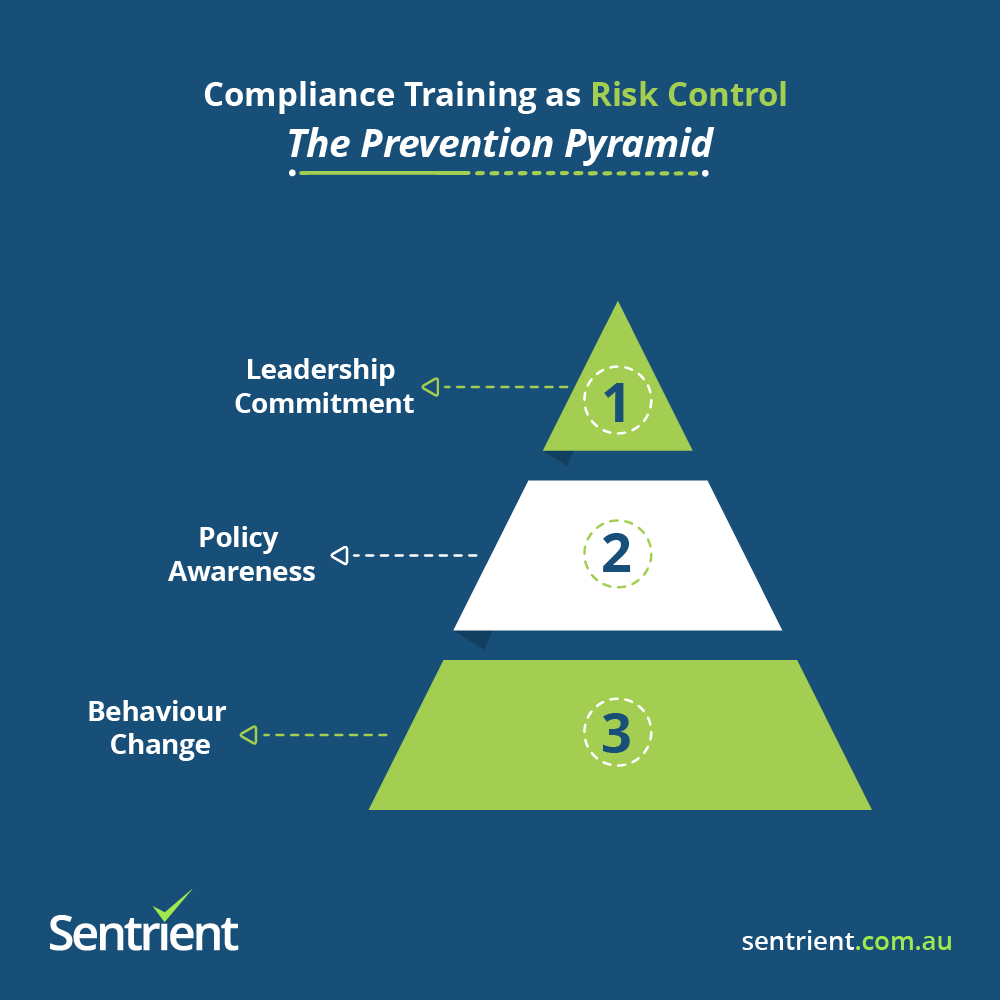In today’s regulatory landscape, compliance training isn’t just a tick-box exercise – it’s the cornerstone of an effective Governance, Risk, and Compliance (GRC) strategy that protects your organisation from costly penalties and reputational damage.
Governance, Risk, and Compliance (GRC) represents the integrated approach organisations use to manage governance structures, identify and mitigate risks, and ensure regulatory compliance. With Australian businesses facing increasingly complex regulatory requirements across work health and safety, privacy, workplace conduct, and industry-specific standards, the role of compliance training has evolved from a compliance afterthought to a strategic business imperative.
While specific figures vary by industry and region, global research indicates that organisations with robust compliance training programs can experience up to 60% fewer compliance violations and save millions in potential fines and legal costs. For Australian businesses operating across multiple jurisdictions, investing in strong compliance frameworks is increasingly critical to mitigating legal and reputational risks.
Understanding GRC Strategy Fundamentals
What Are the Three Pillars of GRC?
1. Governance establishes the framework for decision-making, accountability, and oversight within your organisation.
2. Risk management identifies, assesses, and mitigates potential threats to business objectives.
3. Compliance ensures adherence to laws, regulations, and internal policies.
Compliance training serves as the connecting tissue between these three pillars, transforming abstract policies into actionable knowledge that employees can apply in their daily work.
How Does Compliance Training Overlap with Governance and Risk Management?
Effective compliance training programs align with governance structures by ensuring consistent application of policies across all organisational levels. They support risk management by educating employees on identifying and reporting potential compliance risks before they escalate into costly violations.
| GRC Pillar | Training’s Role | Business Impact |
|---|---|---|
| Governance | Policy implementation and culture building | Consistent decision-making across teams |
| Risk | Early identification and prevention | Reduced incident frequency and severity |
| Compliance | Regulatory knowledge and adherence | Avoided penalties and legal costs |
The Cost of Non-Compliance in Australia
Australian businesses face significant financial and reputational consequences for compliance failures. Work health and safety violations can result in fines of up to $3.6 million for corporations. Additionally, serious or repeated privacy breaches under the Privacy Act 1988 can attract penalties of $50 million or more, making compliance a critical area of risk management.
Beyond financial penalties, non-compliance damages organisational reputation, employee morale, and customer trust – costs that often exceed direct regulatory fines.
The Strategic Role of Compliance Training
Why Move Beyond Checkbox Training Approaches?
Traditional compliance training often focuses on completion rates rather than comprehension and application. Strategic compliance training integrates with broader business objectives, creating measurable value beyond regulatory adherence.
Modern compliance training programs:
- Align with organisational risk appetite and tolerance levels
- Support business growth by enabling confident expansion into new markets
- Build competitive advantage through superior risk management capabilities
- Foster innovation by establishing clear ethical and legal boundaries
How Does Training Create a Culture of Compliance?
Compliance culture emerges when employees understand what they must do, and why compliance matters to organisational success. Effective training programs connect regulatory requirements to personal values and business outcomes.
Key elements of culture-building training include:
- Real-world scenario training that demonstrates practical application
- Leadership modelling where executives participate alongside employees
- Regular reinforcement through micro-learning and refreshers
- Recognition programs that celebrate compliance achievements
Training as a Risk Mitigation Tool
Compliance training functions as a proactive risk control, reducing the likelihood and impact of compliance failures. Well-trained employees serve as the first line of defence against regulatory violations, ethical breaches, and operational risks.

Key Components of Effective Compliance Training in GRC
1. Risk-Based Training Programs
Risk-based training prioritises resources based on the organisation’s specific risk profile. High-risk areas receive more frequent, detailed training, while lower-risk areas receive baseline coverage.
2. Role-Specific Compliance Requirements
Different roles face different compliance obligations. Managers need training on performance management and discrimination laws, while finance teams require anti-bribery and financial reporting compliance education.
3. Regular Training Updates and Refreshers
Regulatory landscapes evolve constantly. Effective programs include:
- Annual comprehensive updates covering major regulatory changes
- Quarterly micro-learning sessions for specific updates
- Just-in-time training for new regulations or incidents
- Refresher training based on risk assessments and audit findings
4. Performance Measurement and Tracking
Robust tracking systems monitor completion rates, assessment scores, and behavioural outcomes. Leading organisations track metrics including:
- Training completion rates by department and role
- Assessment scores and improvement trends
- Incident reduction following training interventions
- Employee confidence levels in handling compliance situations
5. Integration with Existing GRC Frameworks
Training programs must integrate seamlessly with existing GRC tools and processes. This includes linking training records to audit systems, connecting learning objectives to risk assessments, and ensuring training documentation supports compliance reporting requirements.
Building Your Compliance Training Framework
How Do You Conduct Effective Training Needs Assessments?
Systematic needs assessments identify training gaps and prioritise resource allocation. Effective assessments combine:
1. Regulatory requirement mapping across all applicable laws and standards
2. Risk assessment reviews to identify high-priority training areas
3. Employee surveys? to gauge current knowledge levels and confidence
4. Incident analysis to understand where training could prevent future issues
5. Benchmarking against industry best practices and peer organisations
Developing Comprehensive Training Matrices
Training matrices map specific learning requirements to roles, ensuring comprehensive coverage without unnecessary duplication.
| Role Category | Core Compliance | Specialised Training | Frequency |
|---|---|---|---|
| All Employees | WHS, Privacy, Code of Conduct | – | Annual |
| Managers | Above + Performance Management | Discrimination, Workplace Bullying | Annual + Updates |
| Senior Leadership | Above + Governance | Financial Compliance, ESG | Bi-annual |
| High-Risk Roles | Above + Role-Specific | Industry Regulations | Quarterly |
Creating Engaging and Relevant Content
Modern compliance training moves beyond lengthy presentations to interactive, scenario-based learning. Effective content characteristics include:
- Australian context with local case studies and examples
- Interactive scenarios that require active decision-making
- Mobile-friendly formats for flexible access
- Multilingual options for diverse workforces
- Accessible designmeeting WCAG guidelines
Technology and Tools for Compliance Training
Learning Management Systems (LMS) Integration
Modern compliance training relies on sophisticated LMS platforms that integrate with broader GRC systems. Key features include:
- Automated enrolment based on role and risk profiles
- Progress tracking and completion reporting
- Integration with HR systems for seamless user management
- Mobile accessibility for remote and field workers
GRC Software Platforms
Integrated GRC platforms like Sentrient’s solution combine compliance training with incident reporting, policy management, and audit capabilities. This integration ensures training records support broader compliance documentation requirements.
How Can Automation Improve Compliance Training?
Automation enhances training effectiveness through:
- Smart scheduling based on role changes and regulatory updates
- Personalised learning paths adapted to individual knowledge gaps
- Automated reminders for upcoming renewals and deadlines
- Real-time reporting for compliance officers and auditors
Measuring Training Effectiveness
What Are the Key Performance Indicators (KPIs) for Compliance Training?
Effective measurement goes beyond completion rates to assess genuine learning outcomes and behavioural change:
1. Leading Indicators:
- Training completion rates within specified timeframes
- Assessment scores and improvement trends
- Employee engagement metrics (time spent, course ratings)
- Knowledge retention rates in follow-up assessments
2. Lagging Indicators:
- Incident reduction rates following training interventions
- Audit findings related to training effectiveness
- Regulatory citation trends
- Employee confidence surveys
How Do You Calculate ROI for Compliance Training?
Training ROI calculation considers both cost avoidance and efficiency gains:
ROI = (Benefits – Costs) / Costs × 100
Benefits include:
- Avoided fines and penalties
- Reduced incident investigation costs
- Lower insurance premiums
- Improved operational efficiency
Costs include:
- Training platform and content development
- Employee time investment
- Administrative overhead
- Technology infrastructure
Audit Readiness Through Training Records
Comprehensive training documentation demonstrates due diligence to regulators and auditors. Essential documentation includes:
- Individual training completion records
- Competency assessments and scores
- Training content version control
- Effectiveness measurement data
Common Challenges and Solutions
1. Employee Engagement and Participation
- Challenge: Low engagement with mandatory training programs
- Solution: Gamification, microlearning, and relevant scenario-based content
2. Keeping Content Current with Regulatory Changes
- Challenge: Rapidly changing regulatory landscape
- Solution: Subscription-based content updates and automated notification systems
3. Resource Allocation and Budget Constraints
- Challenge: Limited training budgets in smaller organisations
- Solution: Shared training resources, online delivery, and phased implementation
4. Managing Training Across Multiple Jurisdictions
- Challenge: Different requirements across Australian states and territories
- Solution: Centralised platforms with jurisdiction-specific modules
Industry-Specific Considerations
1. Financial Services Compliance Training
Financial services organisations require specialised training in anti-money laundering, responsible lending, and client privacy. Training programs must address ASIC and APRA requirements while supporting cultural change initiatives.
2. Healthcare and Pharmaceutical Requirements
Healthcare organisations need comprehensive training covering patient privacy, medication management, infection control, and therapeutic goods regulations. Training must be role-specific and support continuing professional development requirements.
3. Manufacturing and Environmental Compliance
Manufacturing businesses require training in workplace safety, environmental management, and product compliance. Training programs must address both worker safety and environmental protection obligations.
4. Technology and Data Privacy Training
Technology companies need sophisticated privacy and cybersecurity training addressing Australian Privacy Principles, data breach notification requirements, and emerging cyber threats.
Best Practices for Implementation
1. Securing Executive Leadership Buy-in
Leadership commitment demonstrates organisational priority and ensures adequate resource allocation. Effective approaches include:
- Presenting business case with ROI projections
- Involving leaders in training design and delivery
- Regular reporting on training outcomes and value creation
2. Cross-functional Team Collaboration
Successful programs involve collaboration between:
- HR teams for delivery and administration
- Legal and compliance for content accuracy
- Risk management for priority setting
- IT teams for technology integration
3. Phased Rollout Strategies
Phased implementation reduces risk and allows for continuous improvement:
- Pilot phase with select departments
- Feedback integration and program refinement
- Full rollout with lessons learned applied
- Continuous improvement based on ongoing feedback
4. Change Management Considerations
Effective change management addresses resistance and builds adoption:
- Clear communication about training objectives and benefits
- Regular progress updates and success stories
- Support systems for employees struggling with new requirements
- Recognition and reward programs for compliance champions
Conclusion
Compliance training forms the foundation of effective GRC strategies, transforming regulatory obligations into competitive advantages. Organisations that invest in comprehensive, technology-enabled training programs experience fewer compliance violations, reduced operational risks, and stronger organisational cultures.
Sentrient’s integrated compliance, GRC, and HR platform streamlines training delivery with Australian-specific, legally endorsed compliance resources designed for businesses across all industries. With pre-built compliance courses, automated tracking, and audit-ready reporting, Sentrient enables organisations to build robust compliance training programs without the complexity and cost of traditional solutions.
The advantage of Australian-specific compliance resources cannot be overstated – content designed for local regulatory requirements ensures accuracy, relevance, and effectiveness. Combined with Sentrient’s rapid deployment capabilities, organisations can implement comprehensive compliance training programs in minutes, not months.
Don’t let compliance training be an afterthought in your GRC strategy. Build a program that protects your organisation, empowers your people, and drives business success.
Frequently Asked Questions
1. What is the difference between compliance training and general employee training?
Compliance training specifically addresses legal and regulatory requirements, while general training covers skills and knowledge for job performance. Compliance training is mandatory and must be documented for audit purposes.
2. How often should compliance training be updated and refreshed?
Core compliance training should be updated annually, with immediate updates for significant regulatory changes. High-risk roles may require quarterly refreshers, while general awareness training can be updated as regulations evolve.
3. What are the legal requirements for compliance training documentation in Australia?
Australian law requires organisations to maintain records demonstrating due diligence in compliance efforts. This includes training completion records, content verification, and effectiveness measurement data for regulatory and audit purposes.
4. How can small businesses implement effective compliance training with limited resources?
Small businesses can leverage cloud-based platforms with pre-built content, focus on high-risk areas first, and use online delivery methods to reduce costs. Shared resources and industry-specific templates help maximise limited budgets.
5. What role does leadership play in successful compliance training programs?
Leadership commitment is critical for program success. Leaders must model compliance behaviour, allocate adequate resources, and communicate the importance of training to organisational success and values.
6. How do you measure the ROI of compliance training initiatives?
ROI is measured by comparing training costs against benefits including avoided fines, reduced incidents, lower insurance costs, and improved operational efficiency. Leading organisations track both financial and non-financial benefits.
7. What are the consequences of inadequate compliance training?
Consequences include regulatory fines, legal liability, reputational damage, increased insurance costs, and operational disruptions. Poor training can also lead to employee confusion and increased compliance risks.
8. How can technology improve compliance training delivery and tracking?
Technology enables automated scheduling, personalised learning paths, real-time progress tracking, and integrated reporting. Modern platforms also provide mobile access and integration with broader GRC systems.
9. What should be included in a compliance training needs assessment?
Assessments should include regulatory requirement mapping, risk analysis, current knowledge evaluation, incident review, and benchmarking against industry standards. This ensures training addresses actual organisational needs.
10. How do you ensure compliance training remains engaging and effective?
Use interactive content, real-world scenarios, microlearning modules, and regular updates. Gamification, peer learning, and recognition programs also help maintain engagement while measuring effectiveness through assessments and behaviour change.





